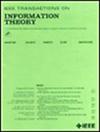Performance Bounds and Degree-Distribution Optimization of Finite-Length BATS Codes
IF 2.2
3区 计算机科学
Q3 COMPUTER SCIENCE, INFORMATION SYSTEMS
引用次数: 0
Abstract
Batched sparse (BATS) codes were proposed as a reliable communication solution for networks with packet loss. In the finite-length regime, the error probability of BATS codes under belief propagation (BP) decoding has been studied in the literature and can be analyzed by recursive formulae. However, all existing analyses have not considered precoding or have treated the BATS code and the precode as two separate entities. In this paper, we analyze the word-wise error probability of finite-length BATS codes with a precode under joint decoding, including BP decoding and maximum-likelihood (ML) decoding. The joint BP decoder performs peeling decoding on a joint Tanner graph constructed from both the BATS and the precode Tanner graphs, and the joint ML decoder solves a single linear system with all linear constraints implied by the BATS code and the precode. We derive closed-form upper bounds on the error probability for both decoders. Specifically, low-density parity-check (LDPC) precodes are used for BP decoding, and any generic precode can be used for ML decoding. Even for BATS codes without a precode, the derived upper bound for BP decoding is more accurate than the approximate recursive formula, and easier to compute than the exact recursive formula. The accuracy of the two upper bounds has been verified by many simulation results. Based on the two upper bounds, we formulate an optimization problem to optimize the degree distribution of LDPC-precoded BATS codes, which improves BP performance, ML performance, or both. In our experiments, to transmit 128 packets over a line network with packet loss, the optimized LDPC-precoded BATS codes reduce the transmission overhead to less than 50% of that of standard BATS codes under comparable decoding complexity constraints.求助全文
约1分钟内获得全文
求助全文
来源期刊

IEEE Transactions on Information Theory
工程技术-工程:电子与电气
CiteScore
5.70
自引率
20.00%
发文量
514
审稿时长
12 months
期刊介绍:
The IEEE Transactions on Information Theory is a journal that publishes theoretical and experimental papers concerned with the transmission, processing, and utilization of information. The boundaries of acceptable subject matter are intentionally not sharply delimited. Rather, it is hoped that as the focus of research activity changes, a flexible policy will permit this Transactions to follow suit. Current appropriate topics are best reflected by recent Tables of Contents; they are summarized in the titles of editorial areas that appear on the inside front cover.
 求助内容:
求助内容: 应助结果提醒方式:
应助结果提醒方式:


